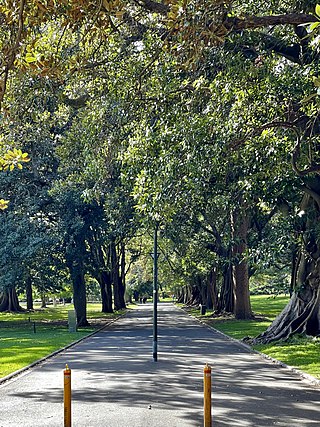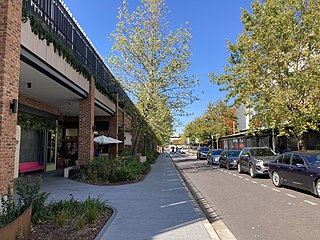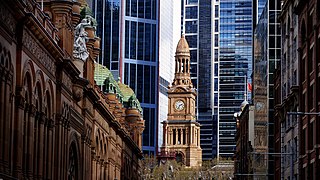
The Sydney Conservatorium of Music (SCM) — formerly the New South Wales State Conservatorium of Music, and known by the moniker "The Con" — is the music school of the University of Sydney. It is one of the oldest and most prestigious music schools in Australia, founded in 1915 by Belgian conductor and violinist Henri Verbrugghen.

The Macquarie Place Park, also known as the Macquarie Place Precinct, is a heritage-listed small triangular urban park located in the Sydney central business district in the City of Sydney local government area of New South Wales, Australia. The former town square and milestone and now memorial, public park and monument is situated on the corner of Bridge Street and Loftus Street. It is named in honour of Governor Lachlan Macquarie. The precinct includes The Obelisk or Macquarie Obelisk, the Sirius anchor and gun/cannon, the Statue of Thomas Sutcliffe Mort, the historic Underground Public Conveniences and the Christie Wright Memorial Fountain. The property was added to the New South Wales State Heritage Register on 5 March 2010.

The Domain is a heritage-listed 34-hectare (84-acre) area of open space on the eastern fringe of the Sydney central business district, in the City of Sydney local government area of New South Wales, Australia. Separating the central business district from Woolloomooloo, The Domain adjoins the Royal Botanic Garden and is managed by The Royal Botanic Gardens and Domain Trust, a division of the NSW Office of Environment and Heritage, an agency of the Government of New South Wales. The Domain is used as a venue for outdoor concerts, open-air events, large political gatherings and rallies, as well as being used daily by the people of Sydney for exercise and relaxation. Along with the Royal Botanic Garden, The Domain was added to the New South Wales State Heritage Register on 2 April 1999.

The Sydney central business district (CBD) is the historical and main commercial centre of Sydney. The CBD is Sydney's city centre, or Sydney City, and the two terms are used interchangeably. Colloquially, the CBD or city centre is often referred to simply as "Town" or "the City". The Sydney city centre extends southwards for about 3 km (2 mi) from Sydney Cove, the point of first European settlement in which the Sydney region was initially established.

The Royal Botanic Garden, Sydney is a heritage-listed major 30-hectare (74-acre) botanical garden, event venue and public recreation area located at Farm Cove on the eastern fringe of the Sydney central business district, in the City of Sydney local government area of New South Wales, Australia.

Woden Town Centre is the town centre of the district of Woden Valley in the Australian Capital Territory. It is located in the suburb of Phillip. The town centre has a variety of shops and amenities, including office blocks that house Australian departments, and shopping centres like Westfield Woden.

Arthur Phillip High School is a coeducational public high school, located in Parramatta, New South Wales, Australia. The school was established in 1960 in its own right, in buildings which had been used continuously as a school since 1875, and is named for Arthur Phillip, the first governor of the state of New South Wales and the founder of the city of Sydney.

Chifley Tower is a skyscraper in Sydney, Australia. It was designed by New York City-based architects Travis McEwen and Kohn Pedersen Fox, with John Rayner as project architect. At a height of 244 metres, Chifley Tower was the tallest building in Sydney from 1992 to 2019. It was surpassed in height by Crown Sydney in 2020 along with the Salesforce Tower and One Sydney Harbour in 2022.

The Museum of Sydney is a historical collection and exhibit, built on the ruins of the house of New South Wales' first Governor, Arthur Phillip, on the present-day corner of Phillip and Bridge Street, Sydney.

The architecture of Sydney, Australia’s oldest city, is not characterised by any one architectural style, but by an extensive juxtaposition of old and new architecture over the city's 200-year history, from its modest beginnings with local materials and lack of international funding to its present-day modernity with an expansive skyline of high rises and skyscrapers, dotted at street level with remnants of a Victorian era of prosperity.

Parliament House,Sydney is a group of heritage-listed buildings which houses the Parliament of the state of New South Wales. The main building is located on the east side of Macquarie Street in Sydney, the capital of New South Wales. The façade consists of a two-storey Georgian building, the oldest public building in the City of Sydney, flanked by two neo-gothic additions containing the parliamentary chambers. These buildings are linked to a 1970s twelve-storey office block at the rear, facing onto the Domain. It is also variously known as the Parliament of New South Wales, Parliamentary Precinct and the Rum Hospital.

The Department of Lands building is a heritage-listed state government administrative building of the Victorian Renaissance Revival architectural style located in Bridge Street in the Sydney central business district of New South Wales, Australia. The large three-storey public building was designed by Colonial Architect James Barnet and built in different stages, with Walter Liberty Vernon and William Edmund Kemp designing various components of the building. The builder was John Young.

Bridge Street is a street in the central business district of Sydney, Australia. Bridge Street runs for 500 metres (1,600 ft) in a west–east direction with traffic flowing in both directions. It is situated in the northern portion of the central business district. The western terminus of Bridge Street is at George Street, with the eastern terminus at Macquarie Street, adjacent to the Chief Secretary's Building. From west to east, Bridge Street crosses Pitt and Phillip streets.

St John's Cathedral is a heritage-listed, Anglican cathedral in Parramatta, City of Parramatta, Sydney, New South Wales, Australia. St John's was given the status of provisional cathedral of the Anglican Diocese of Sydney in 1969, and designated a Regional Cathedral in 2011 for the Western Region. It was added to the New South Wales State Heritage Register on 5 March 2010.

The First Government House was the first residence for the Governors of New South Wales located at 41 Bridge Street, in the Sydney central business district in the City of Sydney local government area of New South Wales, Australia. It was built from 1788 to 1789 and used until 1845, after which it was demolished in 1846. Some of the site is now occupied by the Museum of Sydney. Its construction was attributed to James Bloodsworth. It is also known as First Government House Site, Museum of Sydney and A Rum Rebellion Site. It was added to the New South Wales State Heritage Register on 10 December 1999; and on 19 August 2005 the site was listed on the National Heritage List.
The State Office Block was a landmark modernist skyscraper complex on a block bounded by Phillip, Bent and Macquarie streets in the Sydney central business district. Completed in 1965 and designed in the modernist International style by Ken Woolley from the NSW Government Architect's Office, the 128-metre-high building took the title of the tallest building in Australia from the nearby AMP Building until 1967, the 170 metre Australia Square tower was completed. Designed to hold offices of the NSW Government, including the cabinet and the Premier's office, the State Office Block was demolished in 1997 to make way Aurora Place.

Sydney Cove West Archaeological Precinct is a heritage-listed precinct that contains The Rocks police station, the Museum of Contemporary Art Australia, car park, parks, shops and roads located at 112–156 George Street, in the inner city Sydney suburb of The Rocks in the City of Sydney local government area of New South Wales, Australia. The precinct previously contained a commissariat store, Maritime Services Board offices, dockyard and Department of Labour & Industry offices. Buildings in the precinct were developed in various stages since 1797 to date, with heritage-listed buildings dating from 1797 to 1939. The precinct is also known as the Museum of Contemporary Art, Maritime Services Board, Colonial Government naval dockyard, Commissariat Stores, Colonial Hospital, Kings and Queens Wharf and First Fleet Park. The property is owned by Property NSW, an agency of the Government of New South Wales. It was added to the New South Wales State Heritage Register on 5 August 2011.

History House, Sydney is a heritage-listed former residence, doctor's rooms and clubhouse and now historical society located at 133 Macquarie Street in the Sydney central business district, in the City of Sydney local government area of New South Wales, Australia. It was designed by George Allen Mansfield and built from 1853 to 1872. It is also known as Wickham House. The property is owned by the Royal Australian Historical Society. It was added to the New South Wales State Heritage Register on 2 April 1999.





















